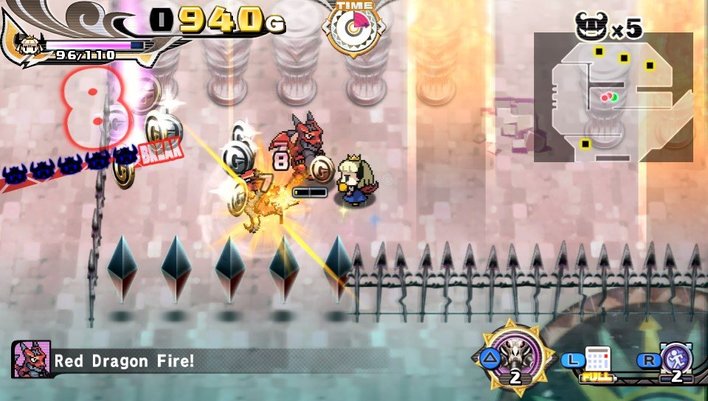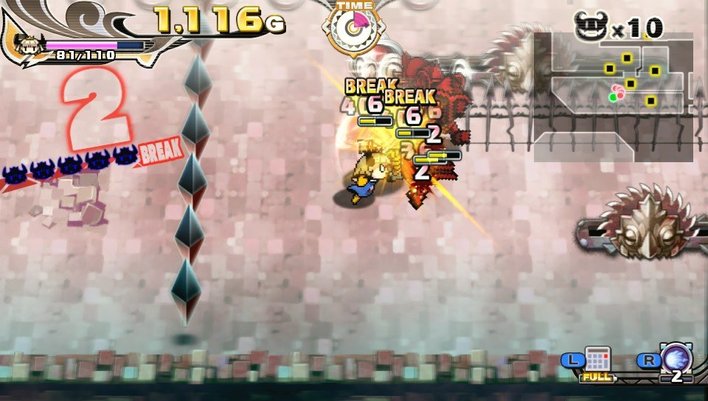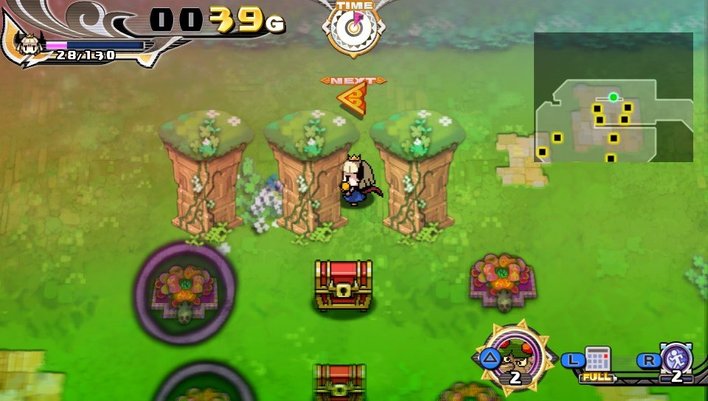With a beetle butler that speaks (or rather, writes) with a thick southern accent; a story that revolves around a Princess who's lost control of her land due to the debt she's accrued to a bunch of dragons; and the ability to bribe any enemies - or even traps - you meet, turning them to your side; Penny Punching Princess is certainly a game with a weird enough concept.

Attacking enemies makes them drop money - and money makes the world go round
Much like in real life, in the world of Penny Punching Princess, there's only one thing that really matters - money. He who has the money makes the rules - or at the very least, has a smoother journey through the game. Taking control of a former Princess, driven mad at having lost control of her kingdom due to her father's debts to the evil Dragoloan empire, it's not so much a satirical story as it is one that's just bizarre - but it certainly does its job for setting the scene.
Determined to get her revenge, and reclaim her kingdom, the young Princess sets out to take out the Dragoloan family one by one, fighting her way through a series of top-down, beat 'em up styled levels on the way. Only here, there's a twist. Taking the old saying "Everybody has a price" to its logical conclusion, the Princess finds herself armed with what we can only assume is a magical calculator, which lets her bribe almost anyone, and anything in game, turning enemies into friends at the first sign of a wodge of cash. While you can still play through each level simply by beating up the enemies that come your way, it's a lot more fun if you use the power of your pocket book to bring them round to your way of thinking. So long as you've got the money, almost any enemy (bar bosses) can be bought - although doing this isn't anywhere near as easy as it should be.

The tougher the enemy, the more they'll cost
In order to bribe an enemy, you'll first have to bring up the game's calculator on screen by holding the L Button. However, rather than pausing the action as you might expect, everything instead just carries on as normal in the background - meaning you'll have to carry on dodging enemy attacks as normal, only now with half of the screen covered by the giant calculator. You've got a choice of two different control schemes here - either touch screen only, or buttons only - although in all honesty, a third "somewhere in the middle" option would have worked infinitely better than either one.
As it stands, using the touch screen controls is a mess. When it comes to the actual bribery, things are fairly straightforward - all you need to do is bodge in a number on the calculator with a spare finger, and then poke the enemy you want to buy. However, actually getting the cash you'll need in order to be able to actually do the bribes is another story. When enemies get stunned, if you're using touch screen controls, you can poke them (rapidly) to basically shake them down, and squeeze some extra cash out of them - but of course, as soon as you start poking them, you've essentially ended up covering half the screen with your finger/hand. Leaving you unable to see what's coming at you, what's attacking you, or even whether the enemy's recovered from being knocked down, and is moving along, the touch screen controls bring with them a whole host of problems - all of which are familiar to games with touch screen controls.

When "BREAK" pops up, you can tap enemies to extort more money. But in doing so, you can't see what's happening in-game...
Using the buttons, however, comes with its own set of issues and problems. In order to input a number on the calculator, you'll need to use the d-pad, which in turn means you can't move and type (unless you have very flexible fingers, and can use both the left stick and d-pad at the same time). Realising this, the game instead gives you the option of holding down the R Button, in order to highlight any nearby enemies (or traps) that can be bought, before letting you cycle through them with the d-pad. Again, though, this still isn't all that easy. When there are a lot of enemies and traps on screen at once, cycling through them all a) takes forever, and b) seems to be a little bit random, with it being more than a bit tricky to predict which enemy the cursor's going to jump to next when you push the d-pad. And of course, while you're busy faffing in the menus, everything in game is still going on.

Which enemy do you want to buy? Which enemy are we even highlighting? Who knows!
Even without worrying about bribing any enemies, the levels here are tricky enough. Short, and designed for on the go play, you won't find any enemies roaming the corridors and plains freely. Instead, upon reaching a certain point, you'll end up triggering an encounter, which causes fences to appear, enemies to spawn in, and all hell to break loose within a tiny, confined area. With many enemies having projectile attacks, and others just charging it you, it can feel more like a bullet hell game at times, as you're left struggling to dodge the attacks coming your way from all directions, all while struggling to keep a calculator under control.
With only a very limited selection of moves at your disposal, you can just about make your way through encounters by punching your way out - but you'll have a far easier time if you can navigate the awkward calculator to buy yourself some help. While buying an enemy does instantly take it out of the fray, it doesn't immediately turn it round to fighting on your side - instead, it'll become a limited-use special move power-up, which you can fire off at your will. Of course, even this isn't without its frustrations, as these attacks are usually really tricky to line up, often leading you to completely waste your move because your attack lands to the side (or behind) who you were aiming for. In fact, this is an issue that raises its head a lot in the game. Due to the angle of the camera, it's often hard to tell exactly where certain obstacles - like the huge boulders that some traps fire - are actually going to hit. Losing a huge chunk of your HP when you genuinely didn't expect to get caught by the boulder isn't all that much fun.
Oh, and did we mention there's no easy, reliable ways to heal yourself? While you will find some very, very limited health restoring panels scattered throughout the level, each is essentially single use - and all are found well outside the realms of the battles. In fact, pretty much the only way to heal your character mid battle is through sheer luck alone. Should a heart shaped character called Life Man appear, if you can manage to find your way around the calculator, you can bribe him, and use him to heal you, restoring a grand total of 70 HP. However, as he has a tendency to hide in amongst large groups of enemies, and doesn't have all that much health himself, far too often you'll end up accidentally taking him out - or bribing the wrong character. And with the calculator having a cooldown before you can use it again, that's another 5-10 seconds you'll need to go without that much needed health...
But beyond all the awkwardness, Penny Punching Princess is a game that is designed to be as deliberately difficult as possible - and one with very few ways of making it any easier. There's no adjustable difficulty here, forcing everyone to play through on the game's default masochistic setting - and though it may claim to be an action role playing game, replaying earlier levels in and of itself won't actually make your character any stronger.

Bribing traps can come in handy when it comes to reaching bits of the map that are otherwise out of reach - like these treasure chests
Instead, character growth is handled through two slightly different, yet related schemes - the zenigami tokens, and the ability to craft armour. In each level, there'll be a small number (usually less than five) zenigami tokens hidden in yellow treasure chests. Find the tokens, and you can spend them on upgrading your skills and stats, like buying yourself a huge extra 10HP - something which doesn't exactly go a long way when some enemies do 35+ in a single hit. More interestingly, the game's crafting system uses the monsters and traps you've caught to determine what upgrades you can create. Letting you make both new armour (which increases both your attack and defence), and Zenigami Statues, with different statues giving you a number of different ability points, each upgrade will require you to have bribed a different number/combination of monsters and traps first. These two features represent the only real way for your character to get stronger - but sadly, neither really makes much of a difference. With levels divided into floors, and the game only having checkpoints at the very start of each floor, you'll lose a lot of progress when you inevitably come a cropper - especially as you'll only get anything to show for your efforts if you do (somehow) manage to make it all the way to the end of a level.
Despite its cutesy looks and appealing premise, then, Penny Punching Princess is a game that's been designed with the gaming masochists in mind, and one that frustrates a lot more than it makes you smile. With awkward controls, a deliberately difficult bribery system, nothing in the way of an adjustable difficulty level, and a punishing learning curve, it's one that's best left for all the hardest of hardcore.
Format Reviewed: PS Vita





















